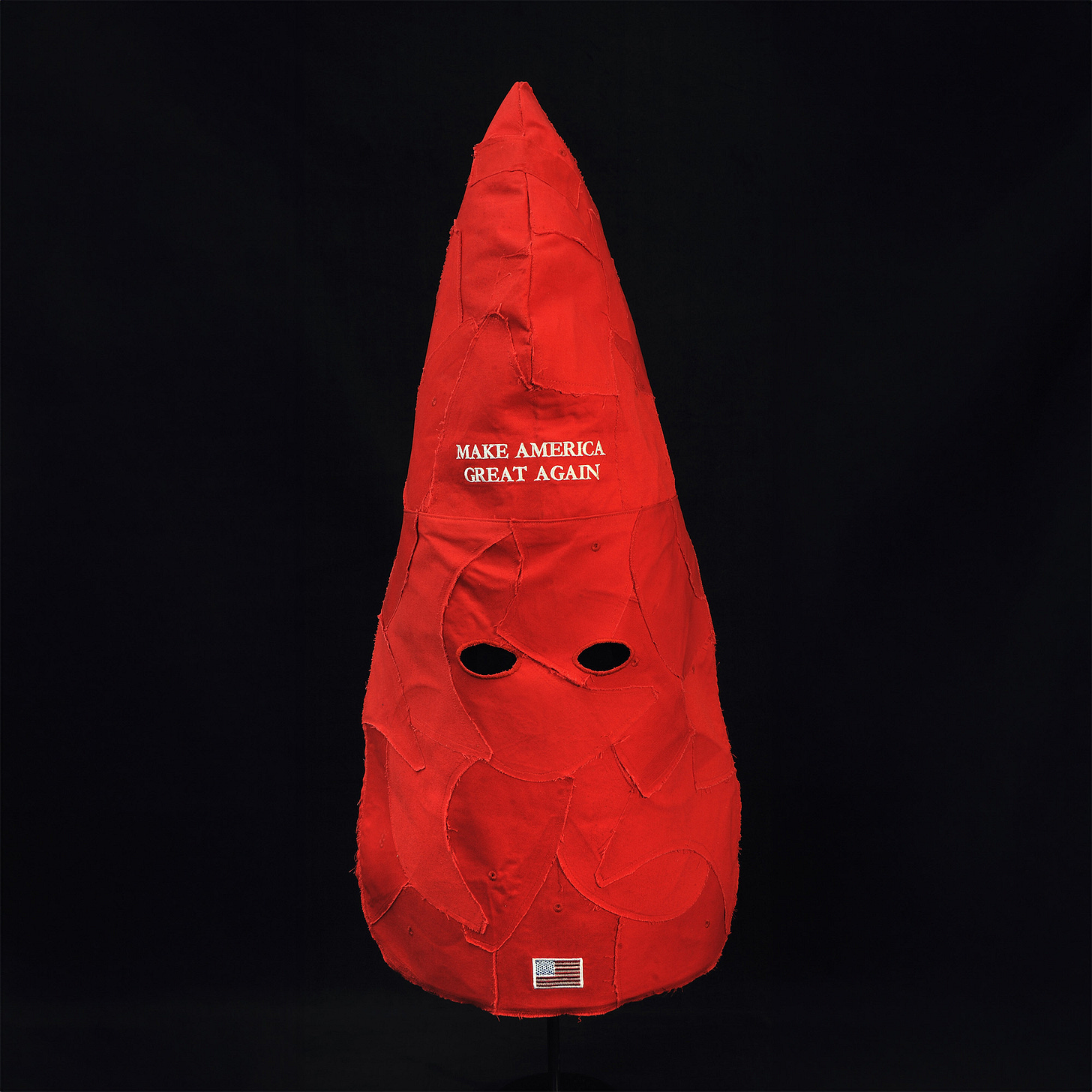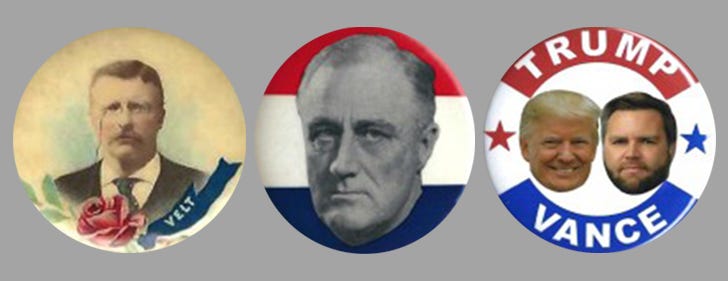Dear Reader,
Is the MAGA hat just another piece of merchandise? According to artist Kate Kretz, the answer is “no.” In her artistic practice, Kretz transforms the MAGA hat into objects that, for her, expose its “true values.”
We came across Kretz’s work a few months ago and wanted to know more about her themes and artistic approach. We already touched on the MAGA hat in this essay, but the topic of political merchandise was so specific that we felt it deserved a follow-up newsletter. That’s why, in the first half of this newsletter, we’re diving into the intersections of political power, consumer culture, and the values these objects embody. In the second half, paid subscribers to something is missing will get access to an exclusive interview with Kate Kretz herself.
Best,
Anton & Nina & Milla
(Milla is a talented student from the Royal Academy of Arts, The Hague, and the first intern at the thing Magazine ever. You can visit her portfolio here. She contributed a LOT to this issue of something is missing.)

Past and Present of Political Merch—or, “Happy Days Are Here Again”
Promotional political products have been a staple in the United States for a long time. George Washington marked his 1789 inauguration with simple buttons that laid the groundwork for American political merchandise. As campaigns and economic circumstances evolved, so did the genre of political promo items. Political buttons remained central to campaigning, but alongside the Industrial Revolution, the range of products expanded. Some presidents, like Theodore Roosevelt, used these items as gifts to forge a personal connection with voters—offering buttons, but also bandanas and ribbons. Franklin D. Roosevelt, by contrast, introduced bold designs and slogans like “Happy Days Are Here Again” in his campaign in 1932, which originated from a song and created urgency or encapsulated his campaign’s core message.

But it was Donald Trump who turned this culture into something different: a tool of power.
Merch America Great Again
The phrase “Make America Great Again” had been used in political campaigns long before Trump’s 2016 election. Ronald Reagan included it in his 1980 acceptance speech, and even Bill Clinton referenced it in 1992. It also appears in Octavia E. Butler’s dystopian novel “Parable of the Talents”, as part of a fictional dictator’s campaign. In 2015, Donald Trump trademarked the phrase, securing exclusive rights to use it for political purposes.
Trump’s merchandise expanded far beyond traditional campaign gear. His brand includes a wide variety of products—extending into his business ventures, such as golfing gear, skincare products, and more. There are clothing items designed for “anyone with an eye for fashion and a love for America,” promising to keep customers “comfortable and looking great.” For example: a crop top with a floral pattern and the Trump logo at the bottom. But the Trump team did not stop there. The Trump Store even sells wooden cutting boards—bringing politics into everyday life in unexpected ways, while profiting from it.
Selling official merchandise became a central fundraising strategy for Trump’s campaign, but the Trump Store, run by the for-profit Trump Organization, also served Trump’s private business interests. Between Election Day, 5 November 2024, and Inauguration Day, 20 January 2025, it launched at least 168 new products—further blurring the line between political branding and personal profit.
One piece in particular came to represent the entire brand: the MAGA hat. Unlike traditional political merch, which usually features the candidate’s name and campaign year, the original MAGA hat had no date. Why add a year if the hat was meant to last forever? After his 2016 victory, the hats were updated with “45” to mark Trump as the 45th president. By 2024, they read “45–47”—suggesting, in the minds of many supporters, that Trump never really stopped being president.
It’s quite difficult to find official figures, but Jared Kushner wrote in his memoir that MAGA hats brought in up to $80,000 per day during the 2016 campaign. In 2024, the campaign reportedly made millions from hat sales, with over two million shipped since early 2023—1.28 million of those between January and October alone, according to Trump officials.
She’s not buying it
Kate Kretz is an Associate Professor at Montgomery College, Maryland, an artist, activist, author, and speaker. In 2019, she began a series made from MAGA hats, which she disassembled and reassembled into new symbolic forms—such as a KKK hood or a swastika armband.

At the time—during Trump’s first term—her work was perceived by many, even left-leaning audiences, as extreme. But what once felt provocative may now be seen through a different lens. “I destroy MAGA hats to reject the claim that they are innocuous,” Kretz says, “I then manipulate and sew the pieces into objects that function as corrective physical manifestations of the truth, revealing their essential nature.” In doing so, she not only unveils what she believes to be the true values behind the MAGA movement, but also demonstrates how objects can encode and replicate meaning. Her work challenges us to see the political dimensions of everyday things—through their production, materiality, symbolism, and use.
Whether or not one agrees with her comparisons, the simplicity of her process—deconstructing one symbol and reassembling it into another—underscores how material objects can be charged with symbolic power. For Kretz, the MAGA pieces are part of a larger pattern she sees in American society: what she calls “bully culture.” It’s a term she uses to describe her long-running series of objects addressing “all the disparate types of bullying—for example, racism, misogyny, homophobia, animal cruelty, gun worship.”
But Kretz didn’t stop at making symbolic objects: She staged a public performance, sitting in front of the White House and dismantling MAGA hats as an act of resistance. This act directly connected the object with the power it represented.
“My process of ripping the symbols apart is one of the most vital aspects of the series,” she explains, “Desecrating all the ugly things they stand for. Brazen lies, bulldozing, gaslighting, intimidation, cruelty, and lack of common decency became normalized under our 45th president.”
A Symbol for What?
During the 2024 presidential campaign, the Trump and Vance online store introduced a new item: the Little Red MAGA Hat—a white cap embroidered with a miniature red MAGA hat.
This piece elevates the power of the original MAGA hat to an almost surrealist level of irony, while also confirming that it has become a logo. And in many ways, it is: labeling a sellable product on the one hand, and symbolizing a brand on the other. It represents not just inclusion or exclusion, but a reclaiming of values in the public sphere. With this move, normalization begins: It’s just a cap, but everyone knows what it stands for. This quiet, collective non-opposition grants wearers a sense of legitimacy. What began as a tool for political campaigning has become a means of maintaining power—a new dimension in the evolution of political merch.
Fashion theorist Gertrud Lehnert coined the term of the “fashion body” to describe how the human body, once dressed in fashion, is transformed into a new entity—a blend of body and performance that becomes a cultural symbol. In 1906, philosopher Georg Simmel described fashion as a mechanism of imitation, a way for individuals to cope with the loneliness of a complex world.
Taken together, these ideas show that the MAGA hat first became a symbolic fashion body—enabling wearers to be publicly “read.” From there, it evolved into a collective movement, uniting people through anger, fear, and isolation. Against the world—and perhaps, even against themselves.
~ RECENTLY ON OUR CHANNELS ~
Light and Materiality – Visiting Sabine Marcelis in Rotterdam
Working on Things: Truly Truly – Our first longform YouTube video ever!
“A Time for Artists to Scream”: An Interview with Kate Kretz on Fear, Truth, and Symbols of Terror
Kate Kretz is an American artist based in Maryland who interrogates systems of power and violence embedded in contemporary society in her practice. Through her #bullyculture series—a body of work exploring the normalization of hate—she addresses issues such as racism, misogyny, homophobia, and authoritarianism. Her MAGA hat series began in 2018 as a response to the Trump administration during his first term, and she now continues working on the series. This interview took place in written form in March 2025, via e-mail.
Keep reading with a 7-day free trial
Subscribe to something is missing to keep reading this post and get 7 days of free access to the full post archives.






